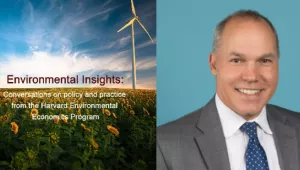The full discussion paper is available for download here:
http://belfercenter.ksg.harvard.edu/publication/19568/
OVERVIEW
Applying a framework developed in an earlier Harvard Project Discussion Paper1, Valentina Bosetti and Jeffrey Frankel describe a system of formulas and country-specific emission targets that would stabilize atmospheric CO2 at 460 parts per million (ppm) by 2100. Their approach addresses the most serious deficiencies of the Kyoto Protocol: the absence of long-term targets, non-participation by the United States and developing countries, and lack of confidence in countries' willingness to abide by emissions commitments. This plan achieves a more stringent environmental target than the earlier Frankel proposal, which stabilized CO2 at 500 ppm, but also imposes higher costs.
DISCUSSION
With international climate negotiations at a crucial juncture, Bosetti and Frankel propose a global cap-and-trade system with quantitative emissions limits assigned to countries in five-year increments to 2100. The formulas used to assign limits obey three political constraints. First, developing countries are not asked to bear any cost in the early years. Second, even later, developing countries are not asked to make a greater sacrifice than the earlier sacrifices of industrialized countries, accounting for income differences. Third, countries are not asked to incur income losses above 3.4 percent (in discounted present value terms) over the course of the century or above 12.6 percent in any single budget period2.
Under this plan, rich nations immediately begin cutting emissions. Between now and 2050, the European Union follows the path laid out in the 2008 European Commission Directive; the United States follows the Waxman-Markey bill passed by the House in June 2009; and Japan, Australia, and South Korea follow recent statements by their own leaders. China, India, and other developing countries accept binding targets that reflect business-as-usual (BAU) emissions in the first decades, but later begin reducing emissions below BAU. This feature addresses the concern that energy-intensive industries will move to developing countries, causing carbon leakage and adverse competitive impacts. Developing countries have an incentive to participate because the initial BAU targets allow them to pursue economic growth while still generating revenue through permit sales. When the time comes for these countries to join mitigation efforts, their emission targets are designed to ensure that they are only being asked to do what is fair in light of actions already taken by others.
The proposal results in a world price of CO2 that rises steadily to $1800 per ton in 2100, according to economic simulations using the WITCH model. Economic losses likewise rise gradually and remain below 3.5 percent of income in all regions through 2055. Later in the century, costs go much higher, especially for China and the transitional economies. Bosetti and Frankel find it is not possible, without violating their political constraints, to attain the more stringent 380 ppm CO2 stabilization target needed to hold expected global warming to 2°C.
KEY FINDINGS & RECOMMENDATIONS
- Any successor-agreement to the Kyoto Protocol should deliver (1) more comprehensive participation, (2) efficiency, (3) dynamic consistency, (4) equity, and (5) compliance. The new system must be viewed as fair, flexible, and credible over time and must avoid imposing tremendous economic sacrifices on any country or region.
- A new agreement must respond to several political realities. First, the United States will not commit to quantitative targets if China and other major developing countries do not do likewise. Second, China and other developing countries are not willing to make sacrifices that they view as contemporaneous with, or different in character from, those of rich countries—nor will they accept an agreement that conflicts with their efforts to industrialize or fails to recognize rich countries' higher per-capita emissions and historic responsibility for current levels of greenhouse gases. Third, near-term targets for developing countries should reflect BAU emissions, but in the long run, no country can be rewarded for having "ramped up" its emissions relative 1990 levels. Fourth, no country will comply with targets that impose undue costs, over time or in any given period.
- To be regarded as "fair," the formulas used to set future emission caps should incorporate three elements: a Progressivity Factor, a Latecomer Catch-up Factor, and a Gradual Equalization Factor. The Progressivity Factor is based on emission targets under Kyoto, adjusted for income; it requires richer countries to make larger cuts relative to BAU. The Latecomer Catch-up Factor requires nations that did not agree to binding targets under Kyoto to make gradual reductions to account for their additional emissions since 1990. It is designed to avoid rewarding latecomers with higher targets or creating incentives for countries to ramp up emissions before signing the agreement. The Gradual Equalization Factor addresses equity concerns by incrementally moving per-capita emissions in each country toward a common global average over time.
CONCLUSION
By allocating emission targets in a way that ensures that no country is being asked to do more than its fair share relative to other countries, avoids imposing an undue economic burden on any participant, and can be adjusted over time with changing circumstances, the proposed framework offers a more practical and viable path forward than other proposals to date. Some may conclude that the costs of achieving stabilization at 460 ppm using this framework are still too high. Whatever stabilization target is ultimately chosen, however, the basic approach described here offers a pragmatic policy solution to the current stalemate in international negotiations.
1The earlier paper by Frankel, "An Elaborated Proposal for Global Climate Policy Architecture: Specific Formulas and Emission Targets for All Countries in All Decades," is available at http://belfercenter.ksg.harvard.edu/publication/18597
2By contrast, the earlier Frankel proposal is designed to limit the maximum discounted income loss incurred by any individual country to 1 percent overall and 5 percent in any single budget period.
Bosetti, Valentina and Jeffrey Frankel. “Global Climate Policy Architecture and Political Feasibility: Specific Formulas and Emission Targets to Attain 460 PPM CO2 Concentrations—Summary.” Harvard Project on Climate Agreements, Belfer Center, November 2009





